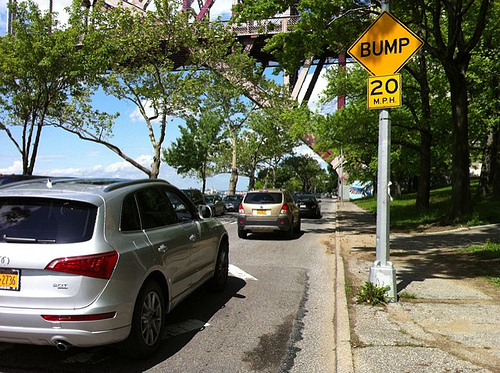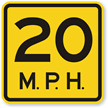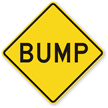(INFOGRAPHIC) Obscure law could trigger 20mph New York City speed limit
Last week, we discussed how greatly improved pedestrian casualty rates had led neighborhoods to request localized changes to the New York City speed limit – but the NYCDOT claimed that they didn’t have the budget for the switch. Now, it looks like an oft-forgotten rule might mean trigger a speed limit drop not just in some neighborhoods, but nearly everywhere within city limits.
The majority of New York City’s streets are located within close proximity to schools, reports WNYC, which, by law, means that the speed limit can be lowered to 20 mph without approval from Albany. In a detailed map, WNYC shows that two thirds of the city’s streets are within a quarter mile of a school. State law specifies that the City can lower speed limits on streets within a quarter mile.
When including both public and private schools, 87% of Manhattan streets, 82% of Brooklyn streets and 74% of streets in the Bronx fall within this designation. Even in Staten Island, which has the lowest density of schools, four out of every 10 miles of streets would be affected. The WNYC analysis does not include day care centers, which are also subject to the speed restriction. It’s likely that even more streets will be impacted when considering day care centers.
Speed restrictions are drawing attention with the recent traffic deaths of children, such as 12-year old Sammy Cohen Eckstein, who was killed — “with the light in his favor,” as his mother told a city council transportation committee meeting on speeding — as he crossed a Park Slope intersection to get a soccer ball. Traffic deaths, Paul Steely White, executive director of Transportation Alternatives, said at the same meeting, are “the leading preventable cause of death for children under the age of 15.” In New York City, at least five children aged 12 and under were killed by drivers in August, September, and October of this year.
Last month, the NYC Department of Transportation told the City Council transportation committee that state law allows the city to regulate speeds at 15 to 24 miles per hour — but only if other physical traffic-calming methods are also used. However, those other methods are not necessary if the street is within a quarter mile of a school. As per the WNYC evaluation, two thirds of the city streets fit that bill.

A 20 mph sign in Astoria, Queens. From the superb Flickr photographer neotint.
Legislation regulating speeding in the city is drawing support from many politicians. Intro 535, proposed by Council Member David Greenfield, would require the city’s Department of Transportation to set speed limits at no greater than 20 miles per hour, down from the current citywide 30 mph limit, “on all streets fewer than sixty feet wide in areas zoned for residential purposes.” James Vacca, City Council transportation chair, told WNYC that he planned to “push legislation in the council to limit speeds in those areas.” He also said that he would like to take a bill to the full council prior to Mayor Michael Bloomberg’s departure from office.
While Mayor Bloomberg and Transportation Commissioner Janette Sadik-Khan have helped drop vehicular deaths to the lowest levels on record, the NYPD has often been cited for poor speeding enforcement, and has issued more tickets for such infractions as tinted windows than for speeding, according to WNYC. Mayor-elect Bill de Blasio supports Intro 535, and has promised to significantly reduce traffic fatalities and serious injuries. De Blasio’s “Vision Zero” plan aims to reduce traffic deaths to zero total within the next decade, with the help of traffic-calming methods near schools.
Category: News & New Products, Pedestrian safety, Road safety, Traffic law

















